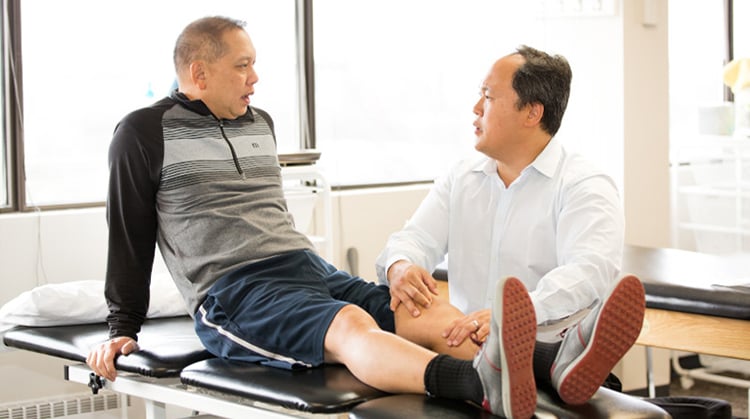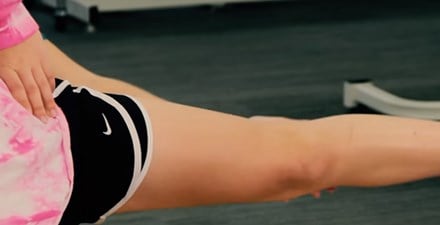Physical Therapy Guide to Lateral Collateral Ligament Sprain and Injury
A lateral collateral ligament sprain occurs when the ligament on the outer side of the knee is overstretched. Collateral ligament knee injuries make up about 25% of severe knee injuries in the United States. They most often occur in adults aged 20 to 34 years and 55 to 65 years. LCL sprains mainly happen during sporting activities, including contact and noncontact sports. They affect women and men equally. Physical therapists treat people with LCL sprains to reduce pain, swelling, stiffness, and any related weakness in the knee or lower extremity.
Physical therapists are movement experts. They improve quality of life through hands-on care, patient education, and prescribed movement. You can contact a physical therapist directly for an evaluation. To find a physical therapist in your area, visit Find a PT.
What Are Lateral Collateral Ligament Injuries?
The LCL is a thick, strong band of tissue that connects the thighbone to the shinbone. It is located on the outer side of the knee. It helps keep the knee joint stable. It is one of several ligaments that support the knee. The LCL can be injured if the knee is hit on the inner side, which pushes the knee outward. An LCL injury also can occur if the knee straightens too quickly or forcefully (hyperextends), causing stress on the outer side of the knee. Changing direction quickly while running or turning sharply with your foot planted on the ground can cause an LCL injury. There are three types of LCL injuries:
- Sprain (an overstretched ligament).
- Partial tear.
- Complete tear.
How Does It Feel?
With an LCL sprain or injury, you may feel:
- Swelling on the outside of the knee.
- Pain on the outside of the knee.
- Tenderness on the outside of the knee.
- A feeling that the knee is locking, catching, buckling, or giving way during movement.
The pain of an LCL sprain or injury may cause you to limp.
How Is It Diagnosed?
If you see a physical therapist first, they will conduct a thorough evaluation that includes your health history. Your physical therapist also will ask you detailed questions about your injury, such as:
- How and when did you notice the pain?
- Did you feel pain or hear a “pop” when you injured your leg?
- Did you turn your leg with your foot planted on the ground?
- Did you change direction quickly while running?
- Did your knee straighten out very quickly?
- Did you receive a direct hit to the leg while your foot was planted on the ground?
- Did you see swelling around the knee in the first two to three hours following the injury?
- Does your knee feel like it is locking, catching, buckling, or giving way when you try to use it?
Your physical therapist will perform tests to help determine the likelihood that you have an LCL sprain. They will gently press on the outer side of your knee to see if it is painful. They also will press on the inner side of the knee to see if that causes pain on the outer side. They may use other tests to determine if there is an injury to other parts of your knee and will watch how you walk.
Your physical therapist may team with an orthopedic doctor or other health care provider. An X-ray or other imaging tests may be done to confirm the diagnosis and rule out other damage to your knee, including fracture.
An LCL sprain rarely requires surgery. If you have a partial LCL tear that fails to heal, or if the tear is severe, surgery may be needed.
How Can a Physical Therapist Help?

Your physical therapist will design a treatment program and work with you to speed your recovery from an LCL sprain. This program will include exercises that you can do at home. Physical therapy will help you return to your normal lifestyle and activities. The time it takes to heal an LCL sprain varies with each person.
First 24 to 48 Hours
During the first 24 to 48 hours following the sprain, your physical therapist may advise you to:
- Rest the area by using crutches or a brace.
- Avoid walking or any activity that causes pain.
- Apply ice packs to the area for 15 to 20 minutes every two hours.
- Consult with a physician for further services, such as medication or diagnostic tests.
Your physical therapist will work with you over time to:
Reduce pain and swelling. Your physical therapist may use different treatments and technologies to control and reduce your pain and swelling. These may include ice, heat, ultrasound, electrical stimulation, taping, exercises, and hands-on therapy.
Improve motion. Your physical therapist will select activities and treatments to help restore normal movement in your knee and leg. These might begin with gentle “passive” motions that your physical therapist performs for your leg and knee joint. You will learn and progress to active exercises and stretches that you do yourself.
Improve flexibility. Your physical therapist will determine if your leg muscles are tight. They will teach you how to stretch them to improve flexibility and reduce stress on your knee.
Improve strength. Specific exercises will aid healing at each stage of recovery. Your physical therapist will choose the right exercises and equipment for your condition. Doing them will help to steadily restore your strength and agility. These may include using:
- Cuff weights.
- Elastic bands.
- Weightlifting equipment.
- Cardio equipment (such as treadmills or stationary bicycles).
Improve balance and agility. Regaining your sense of balance is important after an injury. For athletes, restoring agility (the ability to move quickly and easily) also is important. Your physical therapist will teach you exercises to improve your balance and agility skills.
Speed recovery time. Your physical therapist will use their training and experience to choose the best treatments and exercises for you. They will help you heal, return to your normal lifestyle, and safely reach your goals faster than you are likely to do on your own.
Return to activities. Your physical therapist will discuss your goals with you and use them to set your work, sport, and homelife recovery goals. Your treatment program will help you reach those goals in the safest, fastest, and most effective way possible. Your physical therapist will help you achieve your goals by teaching you:
- Specific exercises.
- Work-retraining activities.
- Sport-specific techniques and drills.
If Surgery Is Necessary
Surgery is extremely rare in cases of LCL sprains. However, if you have an LCL tear or injury to other parts of your knee at the same time, you may need additional treatment that might include surgery. After surgery you will follow a recovery program over several weeks guided by your physical therapist. They will help you minimize pain, regain motion, strength, and agility, and return to your activities in the safest and fastest manner possible.
Can This Injury or Condition Be Prevented?
Your physical therapist can recommend a home exercise program to reduce your risk for future injury. Exercises may include those that strengthen and stretch the muscles around your knee, upper leg, and core.
To help prevent a recurrence of the injury, your physical therapist also may advise you to:
- Learn correct knee positioning when taking part in athletic activities.
- Follow a consistent flexibility and strength exercise program, especially for the hamstrings (back of the thigh) and quadriceps (front of the thigh) muscles.
- Maintain good overall physical conditioning, even in a sport’s off-season.
- Practice balance and agility exercises and drills.
- Always warm up before starting a sport or heavy physical activity.
- Wear shoes that fit well and are in good condition.
- Maintain a healthy weight.
What Kind of Physical Therapist Do I Need?
All physical therapists are prepared through education and experience to treat LCL sprains. However, you may want to consider:
- A physical therapist who has experience in treating people with orthopedic injuries. Some physical therapists have a practice with an orthopedic focus.
- A physical therapist who is a board-certified clinical specialist or who completed a residency or fellowship in orthopedic or sports physical therapy. This physical therapist has advanced knowledge, experience, and skills that may apply to your condition.
You can find physical therapists who have these and other credentials by using Find a PT, the online tool built by the American Physical Therapy Association to help you search for physical therapists with specific clinical expertise in your geographic area.
General tips when you’re looking for a physical therapist (or any other health care provider):
- Get recommendations from family, friends, or other health care providers.
- When you contact a physical therapy clinic for an appointment, ask about the physical therapists' experience in helping people who have your type of injury.
- Be prepared to describe your symptoms in as much detail as possible, and say what makes your symptoms worse.
The American Physical Therapy Association believes that consumers should have access to information that could help them make health care decisions and also prepare them for a visit with their health care provider.
The following articles provide some of the best scientific evidence related to physical therapy treatment of your injury. The articles report recent research and give an overview of the standards of practice both in the United States and internationally. The articles link to a PubMed* abstract which may offer the free full text so you can read them or print out a copy to bring with you to your health care provider.
Davenport D, Arora A, Edwards MR. Non-operative management of an isolated lateral collateral ligament injury in an adolescent patient and review of the literature. BMJ Case Rep. 2018;2018:bcr2017223478. Article Summary on PubMed.
Thaunat M, Pioger C, Chatellard R, et al. The arcuate ligament revisited: role of the posterolateral structures in providing static stability in the knee joint. Knee Surg Sports Traumatol Arthrosc. 2014;22(9):2121–2127. Article Summary on PubMed .
Kim YH, Purevsuren T, Kim K, Oh KJ. Contribution of posterolateral corner structures to knee joint translational and rotational stabilities: a computational study. Proc Inst Mech Eng H. 2013;227(9):968–975. Article Summary on PubMed.
DeCarlo M, Armstrong B. Rehabilitation of the knee following sports injury. Clin Sports Med. 2010;29:81–106. Article Summary on PubMed.
Schorfhaar AJ, Mair JJ, Fetzer GB, et al. Knee: lateral and posterolateral injuries of the knee. In: DeLee JC, Drez D Jr, Miller MD, eds. DeLee & Drez’s Orthopaedic Sports Medicine: Principles and Practice. 3rd ed. Philadelphia, PA: Saunders Elsevier; 2009: chap 23; sec F. Article Summary Not Available.
Irrgang JJ, Fitzgerald GK. Rehabilitation of the multiple-ligament-injured knee. Clin Sports Med. 2000;19(3):545–571. Article Summary on PubMed.
Meislin RJ. Managing collateral ligament tears of the knee. Phys Sportsmed. 1996;24(3):67-80. Article Summary on PubMed.
Paletta GA, Warren RF. Knee injuries and Alpine skiing: treatment and rehabilitation. Sports Med. 1994;17(6):411–423. Article Summary on PubMed.
* PubMed is a free online resource developed by the National Center for Biotechnology Information. PubMed contains millions of citations to biomedical literature, including citations in the National Library of Medicine’s MEDLINE database.
Expert Review:
Apr 13, 2020
Revised:
Apr 13, 2020
Content Type: Guide
Lateral Collateral Ligament Injury
PT, DPT
James E. Zachazewski
PT, DPT, board-certified clinical specialist in sports physical therapy, on behalf of the Academy of Sports Physical Therapy
Andrea Avruskin
PT, DPT
You Might Also Like...
Video
Preventing Injuries in Youth Soccer PlayersOct 13, 2016
Skye Donovan, PT, PhD, discusses common injuries that affect youth soccer players and how to prevent them.
